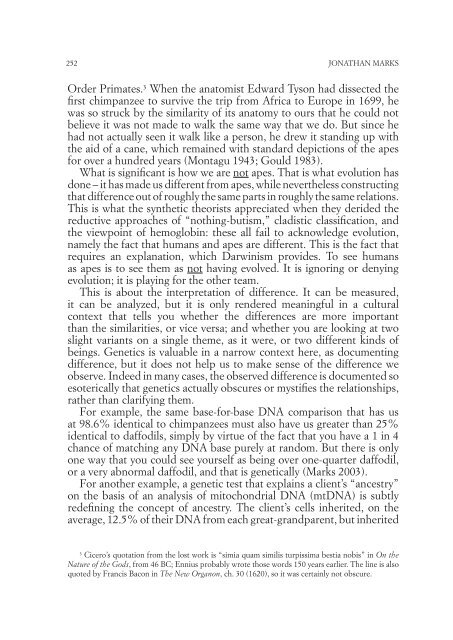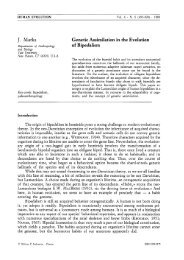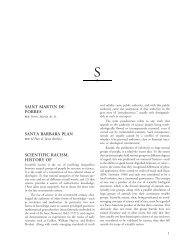What is the Viewpoint of Hemoglobin, and Does It Matter?
What is the Viewpoint of Hemoglobin, and Does It Matter?
What is the Viewpoint of Hemoglobin, and Does It Matter?
- No tags were found...
You also want an ePaper? Increase the reach of your titles
YUMPU automatically turns print PDFs into web optimized ePapers that Google loves.
252 jonathan marksOrder Primates. 3 When <strong>the</strong> anatom<strong>is</strong>t Edward Tyson had d<strong>is</strong>sected <strong>the</strong>first chimpanzee to survive <strong>the</strong> trip from Africa to Europe in 1699, hewas so struck by <strong>the</strong> similarity <strong>of</strong> its anatomy to ours that he could notbelieve it was not made to walk <strong>the</strong> same way that we do. But since hehad not actually seen it walk like a person, he drew it st<strong>and</strong>ing up with<strong>the</strong> aid <strong>of</strong> a cane, which remained with st<strong>and</strong>ard depictions <strong>of</strong> <strong>the</strong> apesfor over a hundred years (Montagu 1943; Gould 1983).<strong>What</strong> <strong>is</strong> significant <strong>is</strong> how we are not apes. That <strong>is</strong> what evolution hasdone – it has made us different from apes, while never<strong>the</strong>less constructingthat difference out <strong>of</strong> roughly <strong>the</strong> same parts in roughly <strong>the</strong> same relations.Th<strong>is</strong> <strong>is</strong> what <strong>the</strong> syn<strong>the</strong>tic <strong>the</strong>or<strong>is</strong>ts appreciated when <strong>the</strong>y derided <strong>the</strong>reductive approaches <strong>of</strong> “nothing-but<strong>is</strong>m,” clad<strong>is</strong>tic classification, <strong>and</strong><strong>the</strong> viewpoint <strong>of</strong> hemoglobin: <strong>the</strong>se all fail to acknowledge evolution,namely <strong>the</strong> fact that humans <strong>and</strong> apes are different. Th<strong>is</strong> <strong>is</strong> <strong>the</strong> fact thatrequires an explanation, which Darwin<strong>is</strong>m provides. To see humansas apes <strong>is</strong> to see <strong>the</strong>m as not having evolved. <strong>It</strong> <strong>is</strong> ignoring or denyingevolution; it <strong>is</strong> playing for <strong>the</strong> o<strong>the</strong>r team.Th<strong>is</strong> <strong>is</strong> about <strong>the</strong> interpretation <strong>of</strong> difference. <strong>It</strong> can be measured,it can be analyzed, but it <strong>is</strong> only rendered meaningful in a culturalcontext that tells you whe<strong>the</strong>r <strong>the</strong> differences are more importantthan <strong>the</strong> similarities, or vice versa; <strong>and</strong> whe<strong>the</strong>r you are looking at twoslight variants on a single <strong>the</strong>me, as it were, or two different kinds <strong>of</strong>beings. Genetics <strong>is</strong> valuable in a narrow context here, as documentingdifference, but it does not help us to make sense <strong>of</strong> <strong>the</strong> difference weobserve. Indeed in many cases, <strong>the</strong> observed difference <strong>is</strong> documented soesoterically that genetics actually obscures or mystifies <strong>the</strong> relationships,ra<strong>the</strong>r than clarifying <strong>the</strong>m.For example, <strong>the</strong> same base-for-base DNA compar<strong>is</strong>on that has usat 98.6% identical to chimpanzees must also have us greater than 25%identical to daffodils, simply by virtue <strong>of</strong> <strong>the</strong> fact that you have a 1 in 4chance <strong>of</strong> matching any DNA base purely at r<strong>and</strong>om. But <strong>the</strong>re <strong>is</strong> onlyone way that you could see yourself as being over one-quarter daffodil,or a very abnormal daffodil, <strong>and</strong> that <strong>is</strong> genetically (Marks 2003).For ano<strong>the</strong>r example, a genetic test that explains a client’s “ancestry”on <strong>the</strong> bas<strong>is</strong> <strong>of</strong> an analys<strong>is</strong> <strong>of</strong> mitochondrial DNA (mtDNA) <strong>is</strong> subtlyredefining <strong>the</strong> concept <strong>of</strong> ancestry. The client’s cells inherited, on <strong>the</strong>average, 12.5% <strong>of</strong> <strong>the</strong>ir DNA from each great-gr<strong>and</strong>parent, but inherited3Cicero’s quotation from <strong>the</strong> lost work <strong>is</strong> “simia quam simil<strong>is</strong> turp<strong>is</strong>sima bestia nob<strong>is</strong>” in On <strong>the</strong>Nature <strong>of</strong> <strong>the</strong> Gods, from 46 BC; Ennius probably wrote those words 150 years earlier. The line <strong>is</strong> alsoquoted by Franc<strong>is</strong> Bacon in The New Organon, ch. 30 (1620), so it was certainly not obscure.




